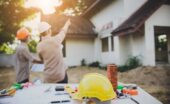Understanding The Risks Associated With Home Building
Written by SayBuild Administration // December 27, 2013 // Home Construction // Comments Off on Understanding The Risks Associated With Home Building

Home builders, renovators and designers face a number of risks when constructing a house. If something goes wrong or if clients are dissatisfied for some reason, these professionals are often the first to take responsibility for the problems. However, where lives and reputations could be lost due to an issue that could have been prevented, business owners should ensure that any risks associated with home building are reduced. Learn what risks are involved and how these problems affect your business.
Work Conditions
Ensuring that work conditions are safe is often the responsibility of the builder or the subcontractor. Without a proper safety program in place, workers, suppliers and even visitors could get injured on site. Construction accidents are costly. Not only does a contractor pay for the cost of medical expenses to the injured, the firm will also have to shoulder the cost of lost time, damaged supplies and equipment, and loss of manpower. Worst, it may even have to face litigation should a case be filed in court.
A safety program is a plan that ensures proper handling and use of supplies and equipment. It also ensures that appropriate steps in building and repairing are followed. It also sets safety standards that everyone involved in the construction must comply with. For example, a safety plan can pressure workers and subcontractors to follow the standards of work safety required. It can also raise the level of experience and training of workers who help with the project. It can also help create a more organized workplace where workers will feel confident, knowing that they are safe and protected.
Damage to the Site
Any building that is a work in progress is potentially dangerous because it is unfinished, and the components of the structure that will make the building safe are not yet completed. An unfinished construction project can also make the components, along with the tools, equipment and other materials vulnerable to damage, pilferage and theft. Walls could collapse, flooring could crack or warp, braces could break, etc. There are also external factors that may contribute to the risks of building a home, such as natural disasters, thieves and vandals.
Damage to Property
Damage to property is a common problem in construction sites. Any business involved in building homes and structures know that a number of things related to construction could happen on site – accidents, equipment malfunction and worker negligence could result to damage to the property of the client. In some cases, the damage can even involve other properties in the vicinity, including those belonging to neighbors, rental services, suppliers and other third parties. Incidents such as these could cost the builder plenty and affect how the business is run from there.
Defective Equipment, Products & Supplies
Another risk that every construction business should be aware of is the use of defective materials for building. Builders are responsible for any defects in the quality of materials and supplies, and in the workmanship and installation involved in the construction of a home. Some problems are easier to fix, especially before the building process is initiated or during the construction phase. Often, the construction business could shoulder the cost of the defect or have any defective materials replaced by the subcontractor or supplier. There is, however, still a bigger risk that could come up years down the line when any defects in the construction of a house could lead to some serious repair and replacement cost.
Previously Unknown Conditions
Building a home can sometimes require excavation work which could reveal unforeseen problems such as underground water, weak soil support, contaminated soil, etc. These issues could result in extra expense to cover for the cost of testing, redesigning, treatments and other corrective actions.
Minimizing the Risks
The size, frequency and extent of an accident, loss, violation and injury does not matter even if it is the smallest, cheapest and most negligible issue. Although eliminating all risks at every project site is impossible, there are ways to minimize problems by implementing steps, standards and regulations that will help prevent and reduce risks significantly. When risks are reduced, a home building business can ensure the safety of its workers and clients, maximize its profits and build a good reputation in the industry.








 If you want to contribute tutorials, news or other money-related stuff:
If you want to contribute tutorials, news or other money-related stuff:  Share our home building library with your facebook friends:
Share our home building library with your facebook friends:  Do you have any ideas or suggestions you would like to make?
Do you have any ideas or suggestions you would like to make?  If you like what we do, please subscribe to our
If you like what we do, please subscribe to our  All content Copyright © 2012 SayBuild. Part of nBuy Home Management Network.
All content Copyright © 2012 SayBuild. Part of nBuy Home Management Network.